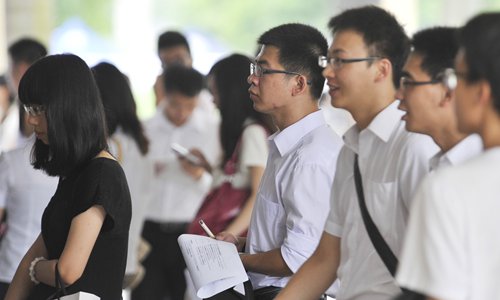
From the People's Daily app.
And this is Story in the Story.
Cases of myopia among students in China are growing, increasingly affecting younger children and to a more serious extent. Short-wave blue light from screens has been found to be especially harmful to children.
Myopia, or short-sightedness, is becoming the new norm for 30 percent of primary school students, 60 percent of junior high school students, and 80 percent of senior high school students in China.
Typical modern habits may be a factor behind the increase in myopia. These include lack of outdoor activity, long hours of screen time, low levels of sunlight exposure and too many tasks that involve reading.
If no effective measures are taken, the number of people with myopia in China is estimated to exceed 700 million, with 40 million to 51.5 million to suffer from high myopia.
Today's Story in the Story looks at how China is dealing with the current myopia trend.

Candidates wearing glasses at a job fair for graduates in Guangzhou, South China's Guangdong Province. (Photo: VCG)
According to the latest research report by the World Health Organization (WHO), there are currently about 1.4 billion people with myopia, nearly half of whom are based in China, roughly making up half of the population.
The nearsightedness rate is 70 percent among Chinese high school and college students, the highest in the world. The rate is more than 30 percent in primary school students, while it is only 10 percent for their peers in the US, WHO's data showed.
China's Ministry of Education released a notice announcing a crackdown on online gaming, citing rising levels of myopia, on August 30, 2018. The move aimed to limit the number of new online video games, taking steps to restrict the time youngsters spend playing games.
The increasing prevalence of myopia has now come to discussion at one of China's most important meetings, at which national political advisers have called for intensified efforts to remedy the situation.
There is some indication that vision issues, especially among the young, will be alleviated down the road.
"Rates of myopia among young people in some areas are drastically high, and the ages of people who first develop myopia keep falling," said Wang Ningli, a member of the 13th National Committee of the Chinese People's Political Consultative Conference, at the annual session of the CPPCC on March 3 in Beijing.
"Doctors and technologies alone cannot control and prevent myopia. A national strategy and joint efforts from all of society are key," said Wang, who is also the director of the Ophthalmic Center at Beijing Tongren Hospital.
The number of people with severe nearsightedness is increasing, which should be dealt with properly, as such conditions can result in blindness, he said.
Wang Ningli answers questions on March 3, 2019. (Photo: Xinhua)
Feng Danli, another CPPCC National Committee member and the chairwoman of Beijing Radiant Children's Eye Hospital, said in recent years more kindergarten students have also developed myopia.
In recent years, screening provided for more than 62,000 children in Beijing found that about 23 percent of those between the ages 4 and 6 did not have 20/20 vision, she said.
"Myopia not only affects the healthy growth of children, but also has a significant impact on national economic development," she said. "In recent years, recruitment campaigns in some industries with higher vision requirements, such as aviation, have encountered increasing difficulty in finding enough qualified people due to the prevalence of myopia," she said.
"In addition to reducing homework loads for students and building vision-friendly classrooms, special laws or regulations should be made to ensure children and teenagers can have adequate rest for their eyes," Feng said.
Feng also suggested establishing vision records for students, and that primary and middle schools and kindergartens conduct at least one vision checkup for students a year to give timely treatment to those with eyesight problems.
Children in rural and especially impoverished areas are less likely to get proper treatment for myopia, and greater efforts should be made to improve equipment and treatment in vision departments at local hospitals and clinics, said He Wei, also a member of the CPPCC National Committee.
Wang, from Beijing Tongren Hospital, said the joint efforts of various parties, including health and education authorities, are crucial in preventing and controlling myopia among students.
The myopia rate among young people in China is expected to noticeably decline by 2030, with the percentage of myopic middle school students falling to below 60 percent, under a plan jointly released by eight ministries and central government departments last year.
(Produced by Nancy Yan Xu, Chelle Wenqian Zeng, Lance Crayon and Brian Lowe. Music by: bensound.com. Text from Global Times and China Daily.)


